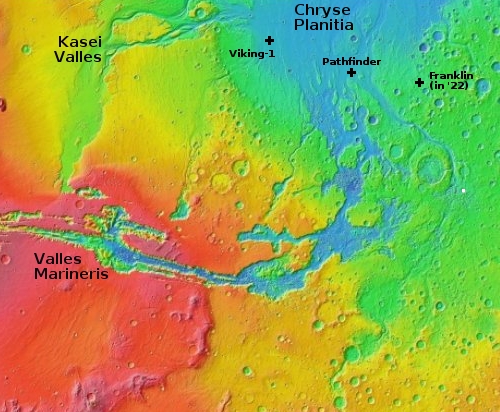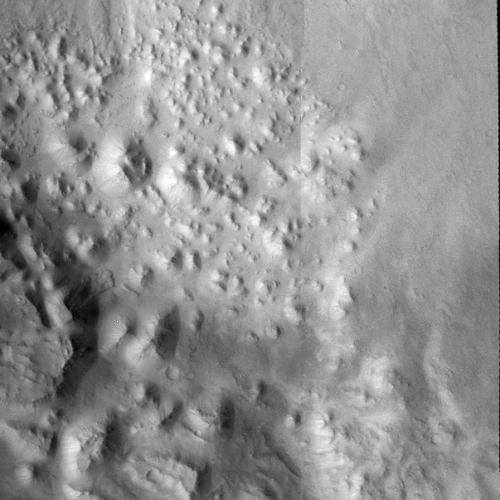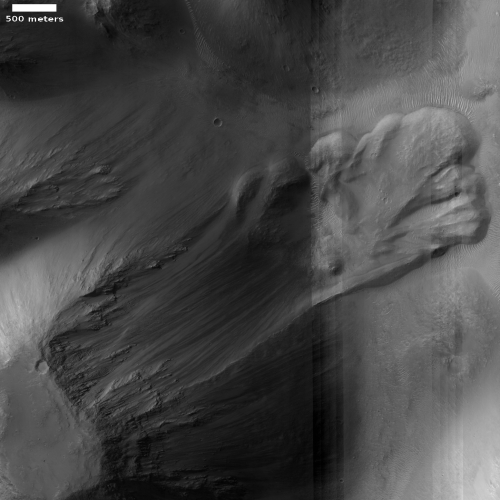How to discover interesting things on Mars

Today’s cool image will do something a little different. We are going to begin in orbit, and by step-by-step zooming in we will hopefully illustrate the great challenge of finding cool geological features on the surface of Mars.
The first image to the right is an overview map of the Valles Marineris region. To its east, centered at the white dot, is a vast region of chaos terrain, endless small buttes and mesas and criss-crossing canyons. Travel in this region will always be difficult, and will likely always require some form of helicopter to get from point to point.
What is hidden in that terrain? Well, to find out you need to take a global survey from orbit with a good enough resolution to reveal some details. Below is a mosaic made from two wide angle context camera pictures taken by Mars Reconnaissance Orbiter (MRO).

For full images go here and here.
This mosaic, rotated, cropped, and reduced to post here, only captures a small section of the long north-south strips taken by MRO. The orbiter has taken tens of thousands of these strips, in its effort to produce a global map of Mars that shows some reasonable detail.
Do you see anything in this mosaic that looks interesting? Scientists need to pore over such images, one by one, searching for geology that is both puzzling and revealing. Sometimes the features are obvious, such as a single blobby crater in the flat relatively featureless northern lowlands.
Sometimes however the search can be slow and time-consuming because the terrain is complex, as is the example to the right. The many mesas and canyons can hide many interesting features. Since MRO can’t possibly take high resolution photos of everything, scientists have to pick and choose.
The planetary scientists who use MRO did find something here worth looking at in high resolution. Can you find it? Normally I’d provide a box to indicate it, but this time I’d thought I’d challenge my readers. Before you click below to see the feature, see if you can find it yourself in this mosaic. What would you want to photograph in high resolution?
This landslide, rotated, cropped, and reduced to post here, was taken on July 23, 2021 by MRO’s high resolution camera. It is located in the center left of the context mosaic above, flowing off the dark cliff.
The slide reveals a number of interesting Martian phenomenon. First, the length of the flow compared to its source cliff illustrates the fast nature of such flows in the low Martian gravity. They appear to go farther on Mars than on Earth. The fluid look of this flow also suggests ice might have been involved. As this feature is practically on the Martian equator, there is no visible ice here or near the surface, so that suggests the flow is very ancient.
The look of the flow should also look very familiar to those who have been following the journey of Perseverance in Jezero Crater. Look at the MRO photo of the crater at this July 2020 post. The delta that flows into Jezero crater looks remarkably like the flow here. The similarity suggests that when Perseverance begins climbing onto that delta its data will help tell scientists something about the flow here, located almost halfway across Mars.
My point with this post however is to show that to find these cool images, scientists have to do a lot of work. The man hours involved are hidden to the general public, making it seem that the discoveries are easy. They are not.
Finding something new or exploring the unknown is always challenging. It always requires a bigger commitment of time and effort than anyone expects. Fortunately, there are many who are willing to dedicate themselves to the task.
On Christmas Eve 1968 three Americans became the first humans to visit another world. What they did to celebrate was unexpected and profound, and will be remembered throughout all human history. Genesis: the Story of Apollo 8, Robert Zimmerman's classic history of humanity's first journey to another world, tells that story, and it is now available as both an ebook and an audiobook, both with a foreword by Valerie Anders and a new introduction by Robert Zimmerman.
The print edition can be purchased at Amazon or from any other book seller. If you want an autographed copy the price is $60 for the hardback and $45 for the paperback, plus $8 shipping for each. Go here for purchasing details. The ebook is available everywhere for $5.99 (before discount) at amazon, or direct from my ebook publisher, ebookit. If you buy it from ebookit you don't support the big tech companies and the author gets a bigger cut much sooner.
The audiobook is also available at all these vendors, and is also free with a 30-day trial membership to Audible.
"Not simply about one mission, [Genesis] is also the history of America's quest for the moon... Zimmerman has done a masterful job of tying disparate events together into a solid account of one of America's greatest human triumphs."--San Antonio Express-News



Excellent review of image analysis – thanks! I personally wish more images were available in 3-D, but I think we’ll have that more commonly at some point, especially as the orbital infrastructure necessary to support even a small colony or exploration base is established.
The very few craters in the low appear elongated in the direction of the flow. My intuition is making it seem as though the flow has actually creeped along a bit since the impacts. Do maybe this is feature is dynamic.
Mars is so weird. Seemingly endless mysteries that may never be solved.
There are a couple of other areas of interest I found. Anybody?
Small edit in second paragraph after first MRO picture: “pore over”
Andi: Thank you as always. Fixed.
I can’t believe I picked the same spot! “That dark, fell off the side thing,” is what I said to myself.
Not a geologist, but I know about some of the tumult in that field over the decades. I look forward to seeing many of the initial Mars theories turn out to be wildly wrong as our knowledge increases.